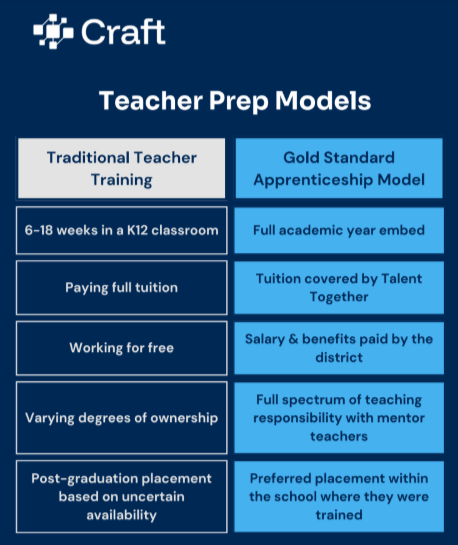Talent Together’s A state-wide apprenticeship program is breaking barriers and building a stronger Teacher pipeline, with support from Craft.
Across Michigan, disconnected workforce education systems were keeping talented people out of teaching. Talent Together, a consortium of all 56 Intermediate School Districts, created registered teacher apprenticeships that remove financial barriers keeping promising educators out of the profession. This case study explores how Talent Together connects systems to close the gap with Craft Connect as the data backbone, enabling scale and success.
“It’s not enough just to bring new teachers into the classroom if they are underprepared, unsupported, and don’t stay in the profession,” said Gina Zuberbier, Program Manager at Talent Together.
The program places aspiring teachers in full-time, paid classroom roles for an entire school year, supported by mentor teachers and backed by formal USDOL standards. This connects state funding, district partnerships, and university training into one seamless system.
Traditional teacher preparation requires unpaid student teaching while paying tuition—impossible for most working adults.
“You’d typically have to quit your job, go to zero income, and pay a university to student teach,” said Bradley Kingston, Director of Data & Analytics. “No one making $30,000 a year can do that. Through our program, teacher candidates get their tuition covered and continue receiving a salary.”
One apprentice on remote Beaver Island completed university coursework virtually while apprenticing locally. Her apprenticeship salary exceeded her previous paraprofessional wage.
Traditional student teaching offers 9 to 18 weeks of experience. Talent Together’s model stretches a full academic year.
“You live through the full cycle—the challenges, the celebrations, the parent interactions,” said Zuberbier. “The only way to get that experience is to live it.”
Traditional student teaching offers 9 to 18 weeks of experience. Talent Together’s model stretches a full academic year.
“You live through the full cycle—the challenges, the celebrations, the parent interactions,” said Zuberbier. “The only way to get that experience is to live it.”

With over 140 apprentices in two years, Talent Together manages complex logistics, compliance, and documentation. Each apprentice represents approximately 10 hours of administrative work. “When you multiply that by 90 to 100 people, you’re talking 900 to 1,000 hours a year just in documentation,” said Kingston. Craft Connect eliminates this burden through automated registration and real-time compliance tracking.
Craft Connect makes tracking progress simple during the school year. It’s where all standards are documented, mentor approvals live, and DOL-compliant registration happens.
“Craft is the only place we document standards progress. Their platform gives us the credibility we need with the DOL and the districts,” said Zuberbier. “A spreadsheet can’t do that.”
Craft Connect makes tracking progress simple during the school year. It’s where all standards are documented, mentor approvals live, and DOL-compliant registration happens.
“Craft is the only place we document standards progress. Their platform gives us the credibility we need with the DOL and the districts,” said Zuberbier. “A spreadsheet can’t do that.”
Funding is the most significant hurdle new programs face. Michigan allocated $78M to support Talent Together through the Michigan Educator Workforce Initiative (MEWI).
Craft configured its platform to meet RAP standards, including Work Process Schedules and Related Instruction Outlines. The result? A passed USDOL audit and a pathway to impact thousands of students.
Early indicators are strong: 54 of 55 apprentices completed their standards, with 65% becoming teachers, significantly improving upon the USDOL average of 35%. They aim to reach 225 new certified teachers by the end of the 2025-2026 school year.
“Everyone knows a kid who goes to public school,” said Zuberbier. “A stronger, more diverse teacher workforce benefits everyone.”
Talent Together proves it’s possible to make teacher preparation more rigorous, effective, and accessible. Their apprenticeship model is a blueprint for connecting workforce education systems nationwide. Talent Together & Craft Education show what’s possible when mission meets method at scale.